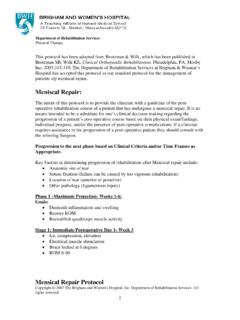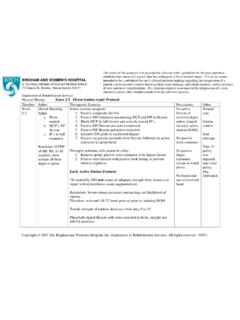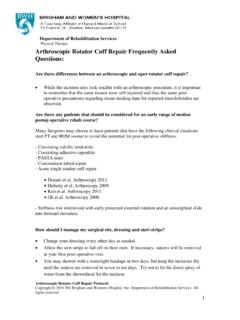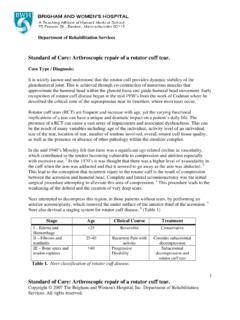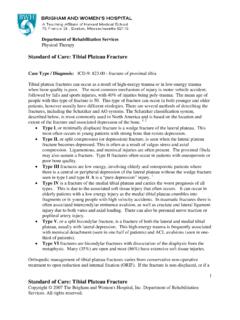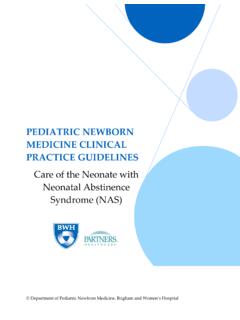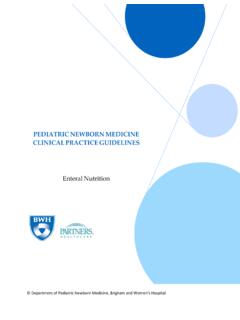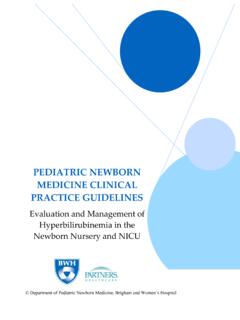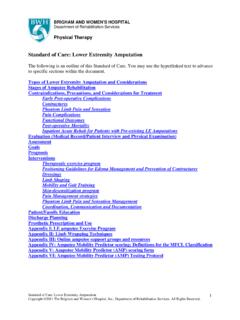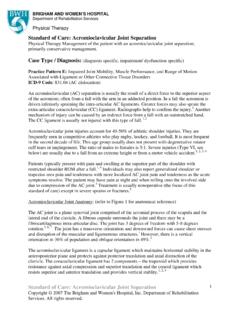Transcription of Standard of Care: Meniscal Tears Conservative management ...
1 Standard of Care: Conservative management of the patient with a Meniscal tear. Copyright 2014 The Brigham and Women's Hospital, Inc., Department of Rehabilitation Services. All rights reserved 1 Department of Rehabilitation Services Physical Therapy Standard of Care: Meniscal Tears Conservative management of the patient with a Meniscal tear. ICD 9 Codes: derangement of the lateral meniscus derangement of the medial meniscus lateral meniscus tear medial meniscus tear Case Type / Diagnosis: Functional Anatomy: The menisci are semi lunar shaped cartilages on the medial and lateral sides of the knee joint.
2 The medial meniscus is semicircular in shape and the lateral meniscus is almost a complete ,10,14 The menisci are held in place firmly to the knee joint capsule by ligaments surrounding the meniscus complex. The medial meniscus is connected to the lateral meniscus anteriorly by the transverse ligament and connected to the patella by the patellomeniscal ligament (a thickening of the anterior capsule) and held in place posteriorly by the semimembranosus muscle, which can affect movement in the medial meniscus as it contracts. The anterior horn of the medial meniscus receives fibers from the anterior cruciate ligament (ACL) and the posterior horn receives fibers from the posterior cruciate ligament (PCL).
3 The lateral meniscus is connected to the medial meniscus by the transverse ligament anteriorly, and to the patella by the patellomeniscal ligament. The lateral meniscus is also anchored posteriorly to the popliteus muscle and the PCL and to the medial femoral condyle via the meniscofemoral ligament. Muscular contractions of the popliteus muscle affects the movement of the lateral The medial meniscus is less mobile than the lateral meniscus secondary to its attachments to the MCL, allowing 2 to 5 mm of translation; this attachment to the MCL may be a contributor to the increased incidence of medial Meniscal tearing.
4 14 In comparison, the lateral meniscus translates 9 to 11mm in the anterioposterior plane. 14 The menisci are 75% type one collagen14. The fibers run along longitudinal (circumferential) and radial patterns. The longitudinal fibers allow for axial loading while radial fibers allow for rotational loading. The peripheral 20%-30% of the medial meniscus and 10%-25% of the lateral meniscus are vascular. 14 Healing is greatly enhanced in the vascular regions and the location of a tear (whether in a vascularized or non-vascularized region) affects treatment decision making. Menisci are innervated with pain receptors and joint mechanoreceptors and as such, pain and altered joint position sense can be expected with Meniscal Standard of Care: Conservative management of the patient with a Meniscal tear.
5 Copyright 2014 The Brigham and Women's Hospital, Inc., Department of Rehabilitation Services. All rights reserved 2 Meniscal motion is determined directly by osseous configuration of the tibiofemoral joint, but the motion is indirectly influenced by contraction of the quadriceps, semimembranosus and popliteus muscles. Meniscal motion follows the direction of femoral condyle displacement. During flexion the femoral condyles compress on the posterior horns causing anterioposterior spread. During knee extension the condyles compress on the anterior horns causing mediolateral deformation. 17 Should the menisci fail to follow the femoral condyles along the tibial plateau they risk entrapment between the two articulating surfaces and sustaining injury due to compression.
6 During terminal knee extension the tibia and femur move in opposite directions, therefore it is during the last 20-30 degrees of extension that the anterior horn of the menisci are at greatest risk. 17 One function of the menisci is to distribute loads across the knee joint. The menisci transmit approximately 50% of the load in weight bearing (extension) and 90% of the load at 90 degrees of knee flexion. The majority of the load is transmitted through the posterior horns with flexion past 90 degrees. 10,17 When Meniscal integrity is compromised, abnormal articular contact stresses result, leading to early degenerative changes.
7 The menisci also play a role in knee stability. Menisci deepen the socket of the tibia to increase contact with the femoral condyles. The meniscus can also help to limit femoral translation on the tibia. The menisci (especially the posterior horn of the medial meniscus ) can be a secondary stabilizer in an ACL-deficient knee, 14 although an ACL tear can also increase the risk of a medial meniscus tear, indicating that the menisci are not always able to handle the increased forces required for stabilization in the ACL-deficient Finally, the menisci have a role in joint lubrication. When the knee is loaded the menisci are compressed and synovial fluid is driven into the articular cartilage, thereby decreasing friction and providing joint nutrition.
8 3,17 Mechanism of Injury and Tear Classifications: Meniscal Tears can be classified as acute or degenerative depending on the mechanism of injury. The most frequent mechanism of acute Meniscal injury is non-contact stress from deceleration or acceleration coupled with a change in direction, commonly seen during a cutting maneuver. Contact stress may also cause a Meniscal tear, from a varus, valgus or hyperextension force coupled with a rotational motion. This mechanism can also result in a concurrent collateral ligament sprain. 17 Playing sports such as soccer and rugby has been found to be a strong risk factor for acute Meniscal Tears .
9 Risk factors for degenerative Meniscal Tears include age (older than 60 years), male gender, work-related kneeling, squatting and stair Classification of Meniscal Tears include: complete or partial, horizontal or transverse, longitudinal/vertical or Horizontal (interstitial) Tears are most often chronic from degenerative changes. These Tears usually do not cause locking but they can progress to flap Tears which can cause popping or clicking. Vertical Tears /longitudina Tears are most often traumatic and result from the forces applied to a healthy meniscus that cause it to split vertically and in line with the circumferentially oriented collagen fibers.
10 These Tears are also known as bucket handle Standard of Care: Conservative management of the patient with a Meniscal tear. Copyright 2014 The Brigham and Women's Hospital, Inc., Department of Rehabilitation Services. All rights reserved 3 Tears . When an unstable fragment from a bucket - handle tear moves into the intracondylar notch it blocks full extension of the knee joint. 14 Radial Tears are those in the central aspect of the meniscus . These Tears may migrate towards the periphery and turn into a parrot beak tear. Signs may include: swelling, giving way or catching. 3,17 Another classification for the type of tear is based on location of the tear in three different zones: red/red, red/white and white/white.
